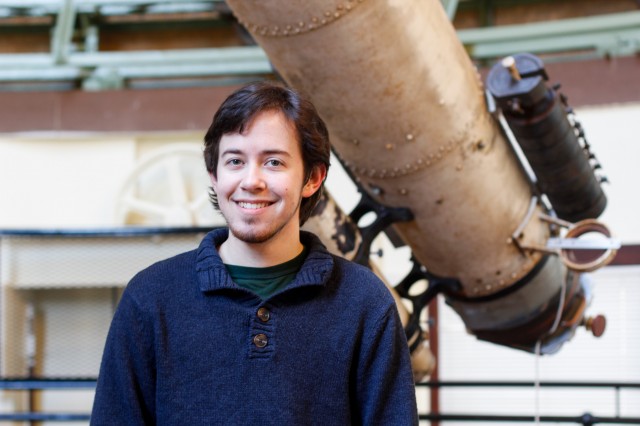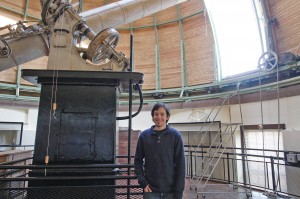BA/MA Astronomy Student Edelman Researching Winds around Stars

In this issue of The Wesleyan Connection, we speak with astronomy graduate student Eric Edelman ’13, who is one of 16 BA/MA students at Wesleyan.
Q: You’re one of only a few who pursue the BA/MA option — it seems like a lot of work. But it seems tailor-made for work in the sciences… Are you still happy with your choice?
A: Absolutely. The BA/MA program provided me with the possibility to realistically pursue astronomy as a late bloomer in the field. I entered Wesleyan with the plan to major in English, and focused my efforts on that path for my first two years here. I took my first introductory course in astronomy and physics as a junior, switched into the astronomy major that semester, and was barely able to complete the bare minimum requirements to receive a BA degree.

Even though I was able to get a degree, the amount of classes I had taken in astronomy and physics in only those two years would not have made me very competitive for Ph.D. programs, which tend to be the next logical step when pursuing a career in astronomy. With the flexibility provided from the BA/MA program, I have been able to stick around for an extra year and really sink my teeth into some incredibly difficult and worthwhile upper level physics and astronomy courses.
Q: The Class of 2018 is getting their admission letters this week. If a prospect is interested in studying sciences, what would you say are the bonuses of studying at Wesleyan?
A: My answer when it comes to physics and particularly astronomy is the student to faculty ratio. It really does literally approach the golden ratio over here. There tend to be around a total of 10-15 graduate and undergraduate majors in the astronomy department per year, with five professors and one postdoc to go around. While trying to land a research position with a professor at larger universities can sometimes feel like being part of a crazy rat race, the astronomy department here at Wes has more than enough space to accommodate any and all students who want to invest themselves in a worthwhile research project. It is an incredibly open and welcoming department.
Not only are our professors approachable and accessible, but also they are extremely well connected. Through my time in the Astronomy Department I have visited the dishes of the Jansky Very Large Array (Yes, the one from the movie Contact!) in New Mexico, observed with the Submillimeter Array on the summit of Mauna Kea in Hawaii, and observed at Yale through their remote connection to the Keck telescope, also situated in Hawaii. All of these experiences were thanks to opportunities provided by professors and programs affiliated with Wesleyan University.
Q: What is the focus of your research and what are you working on?
A: I am finishing up my master’s thesis here at Wes, which involves the process of measuring the winds of stars like our Sun. Particularly, I am focusing on stellar systems that have known planets orbiting them, with the aim of trying to decipher how the measured winds of these stars may affect or potentially even dissipate the atmospheres of their host planets. This is quite an important consideration in terms of the question of life on other planets outside of our solar system. Certainly Earth wouldn’t be much of a fun place to live without an atmosphere!
About 4 billion years ago, Mars lost its own atmosphere, and one question to investigate is whether the Sun’s wind at that time was strong enough to have been a major factor in causing that to happen. By measuring the winds of lots of different stars like our Sun, we can start to figure out a relationship between wind strength and age, and perhaps trace that relationship backwards to discover some of our solar system’s history, as well as trace the relationship forward to predict how the wind may evolve and influence our solar system in the future.
Q: Astronomy and related sciences seem to be hot-hot-hot right now. Why do you think that is? Is it the Neil deGrasse Tyson effect?
A: It is fantastic that so many people have been getting on board the astro train as of late! I bet some of this enthusiasm can be attributed to the International Year of Astronomy that happened in 2009. There was a worldwide push to get all sorts of folks interested in the stars, with one huge draw being a mass production of the Galileoscope. Anyone could buy this awesome little telescope for $15, and could even use it to look at Jupiter’s moons like Galileo once did. Having astronomy so cheap and accessible was a great way to spread the fever. Now, Dr. Tyson is providing another easy way to gape at the universe, with his revamp of the TV series Cosmos. I’m sure it can only be doing good things to astronomy’s public image.
Q: What’s next for you?
A: I’m going to be sticking around Wes for a little bit of the summer to write a scientific paper based on the findings in my thesis. My thesis advisor Seth Redfield and I will be submitting this paper to one of the major astrophysics journals for publishing. I am looking forward to getting my work read and considered by professional astrophysicists in the field!

